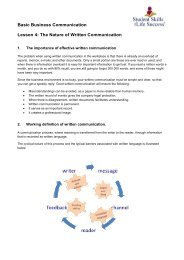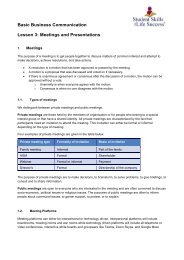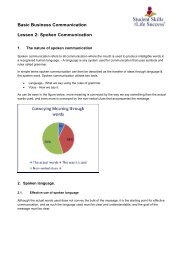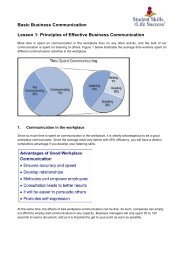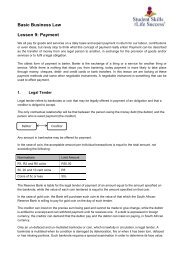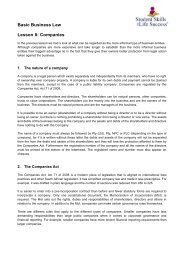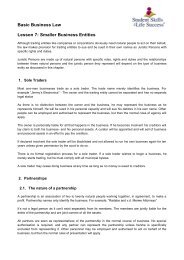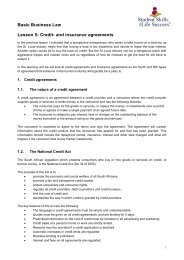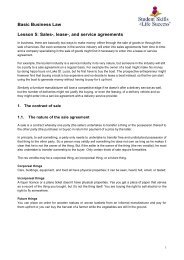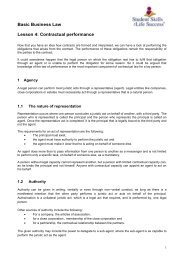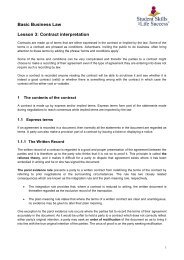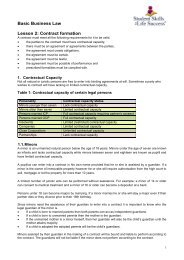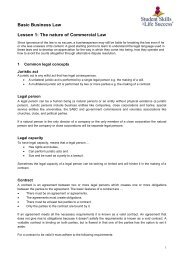Student Skills for Life Success: Advanced Study Skills: Workshop Manual
This is the student workbook for the "Advanced Study Skills" workshop as offered by "Student Skills for Life Success". The workshop is directed at children 13 years and older, who have already completed the "Basic Study Skills" workshop. Interactive workshops are delivered as two 2-hour sessions on consecutive days
This is the student workbook for the "Advanced Study Skills" workshop as offered by "Student Skills for Life Success". The workshop is directed at children 13 years and older, who have already completed the "Basic Study Skills" workshop. Interactive workshops are delivered as two 2-hour sessions on consecutive days
You also want an ePaper? Increase the reach of your titles
YUMPU automatically turns print PDFs into web optimized ePapers that Google loves.
<strong>Advanced</strong><br />
<strong>Study</strong>-<strong>Skills</strong><br />
<strong>Workshop</strong><br />
Name: _________________<br />
Surname: _________________<br />
Grade: _________________<br />
School: _________________
Session 1<br />
1<br />
Good Questioning<br />
2<br />
Creativity<br />
3<br />
Thinking <strong>Skills</strong><br />
4<br />
Visualisation<br />
5 Memory Keys
Good Questioning<br />
The 5W1H method<br />
Use this method when planning an<br />
essay or answering a long question.<br />
Who is it about?<br />
• Appearance<br />
• Characteristics<br />
• Background<br />
• Motivation<br />
What is it about?<br />
• Features<br />
What happened?<br />
• Order of events<br />
Where did it happen?<br />
• The place<br />
When did it happen?<br />
• The date & time<br />
Why did it happen?<br />
• Obvious reasons<br />
• Deeper reasons<br />
How did it happen?<br />
How does it work?<br />
• Details “what”<br />
Sindy - Friendly girl - blue eyes -<br />
small nose<br />
Farm girl - Out to proof herself<br />
Red bicycle - white saddle - blue<br />
peddles<br />
Accident - Car - tree - hospital<br />
Road - school gate<br />
After school - be<strong>for</strong>e debate practice<br />
Didn’t look<br />
Made friends in hospital<br />
She was daydreaming<br />
Pull on handlebars – Bicycle change<br />
direction – Trees don’t move
<strong>Workshop</strong> Activity 1<br />
Read the passage that you received and complete<br />
the following table, using the 5W1H method.<br />
Who? Person 1 Person 2<br />
o Appearance<br />
o Characteristics<br />
o Background<br />
o Motivation<br />
What happened?<br />
What is described?<br />
Where?<br />
When?<br />
Why?<br />
How?
Creativity<br />
Brainstorming<br />
Come up with many different ideas<br />
by getting more people’s input.<br />
Find 50 uses<br />
<strong>for</strong> a hammer<br />
in 5 minutes<br />
Forced Lateral Thinking<br />
Learn to solve a familiar problem in<br />
a new way.<br />
List 10 things a<br />
hammer and an apple<br />
have in common<br />
Uncom<strong>for</strong>table questions<br />
Ask questions like “why”, “why not” and “what if”.<br />
Creative Problem Solving<br />
Solve problems by thinking in new<br />
ways.<br />
What would you<br />
get if you cross a<br />
cat and a panda?<br />
Make up stories<br />
Use similar objects to make up<br />
different stories<br />
Pick 5 toys from<br />
a hat and make<br />
up a story<br />
New ways<br />
Do familiar things in a new way<br />
Alternative uses<br />
Find new ways to use old things<br />
Start eating<br />
your peas first<br />
Build a<br />
puzzle<br />
upside down
<strong>Workshop</strong> Activity 2<br />
Getting Creative<br />
Look at the five objects below and make up a short story<br />
containing all five objects.<br />
________________________________________________________<br />
________________________________________________________<br />
________________________________________________________<br />
________________________________________________________<br />
Create hybrid animals by paring the following animals and come<br />
up with a name <strong>for</strong> your mutation.<br />
__________________________<br />
__________________________<br />
__________________________<br />
DO AT HOME ACTIVITY A<br />
Becoming even more creative<br />
1. See how many uses <strong>for</strong> a hammer you can come up with as a<br />
family.<br />
2. See who can come up with the most similarities between an<br />
apple and a hammer
Thinking <strong>Skills</strong><br />
In school, you spend a lot of time memorizing facts,<br />
but this is only the first step towards creative thinking.<br />
Thinking Step<br />
Thinking Technique<br />
Create<br />
Induce<br />
Deduce<br />
Evaluate<br />
Analyse<br />
Synthesize<br />
Apply<br />
Organise<br />
Use Logic<br />
Understand<br />
Sum-Up<br />
Illustrate<br />
Know<br />
Observe<br />
Memorize<br />
1. Observe<br />
2. Identify<br />
3. Conclude<br />
Induce<br />
Synthesize<br />
Analyse<br />
Deduce<br />
1. Visualise<br />
2. Test<br />
3. Confirm<br />
1. Start with the parts<br />
2. Make the whole<br />
1. Start with the whole<br />
2. <strong>Study</strong> the parts
<strong>Workshop</strong> Activity 3<br />
Understanding the higher-level thinking skills<br />
Match the higher order thinking skills of analysis, synthesis,<br />
induction, and deduction with the icons by applying the correct<br />
label to each.<br />
DO AT HOME ACTIVITY B<br />
Apply the higher-level thinking skills by playing a good board game.<br />
• You need to understand the rules be<strong>for</strong>e you start.<br />
• You must consider all your options be<strong>for</strong>e you make a move.<br />
• Game objectives must be completed in a certain order.<br />
• You need to consider what your opponents are trying to do.<br />
• There are things you cannot control, like the number on the<br />
die, and so, you must change your plans all the time.
Visualisation<br />
Forgetting happens naturally as in<strong>for</strong>mation is transferred<br />
from your short-term memory to your long-term memory.<br />
Wait 9 hours<br />
be<strong>for</strong>e you<br />
study the<br />
same work<br />
again.<br />
Read new work twice, and you will remember about 36%, but<br />
visualize what you read and remember 75% after the second session.<br />
When you visualise, its like playing a movie in your mind.<br />
Principles of Visualisation<br />
1. Relax<br />
2. Build clear images<br />
3. Use all your senses<br />
4. Give it colour<br />
5. Add movement<br />
6. Exaggerate<br />
Writing it out is<br />
less effective than<br />
visualisation, but<br />
better than just<br />
reading
<strong>Workshop</strong> Activity 4<br />
Learn to visualise<br />
Listen to the short story that the facilitator is going to read to<br />
you.<br />
• Close your eyes.<br />
• Do not make notes.<br />
• Try to picture the events in your mind.<br />
• Afterwards rewrite the main points in your own words,<br />
recalling the images that you imagined.<br />
________________________________________________________<br />
________________________________________________________<br />
________________________________________________________<br />
________________________________________________________<br />
________________________________________________________<br />
________________________________________________________<br />
________________________________________________________<br />
________________________________________________________<br />
________________________________________________________<br />
________________________________________________________<br />
________________________________________________________<br />
________________________________________________________<br />
________________________________________________________<br />
________________________________________________________<br />
________________________________________________________<br />
________________________________________________________
Memory Keys<br />
Let’s memorise the “Principles of Visualisation” we saw in the<br />
previous lesson, by using a Memory Key.<br />
1 Start with the list<br />
2<br />
Principles of Visualisation<br />
1. Relax<br />
2. Build clear images<br />
3. Use all your senses<br />
4. Give it colour<br />
5. Add movement<br />
6. Exaggerate<br />
Identify the key words<br />
Principles of Visualisation<br />
1. Relax<br />
2. Images<br />
3. Senses<br />
4. Colour<br />
5. Movement<br />
6. Exaggerate<br />
3<br />
Rearrange them so that<br />
the 1 st letter of each word<br />
can be used in the key<br />
Principles of Visualisation<br />
1. Senses<br />
2. Relax<br />
3. Movement<br />
4. Images<br />
5. Colour<br />
6. Exaggerate<br />
4<br />
5<br />
Use both the keyword and<br />
the topic in a key sentence<br />
Sr Mice know the<br />
principles of visualisation<br />
Create an image to help<br />
you remember the key<br />
sentence
DO AT HOME ACTIVITY C<br />
Make your own memory keys<br />
There are many lists in your textbooks. See if you can apply the<br />
Memory Key Technique to help you memorise some of these lists.<br />
Ask your parents <strong>for</strong> help if you struggle.<br />
________________________________________________________<br />
________________________________________________________<br />
________________________________________________________<br />
________________________________________________________<br />
________________________________________________________<br />
________________________________________________________<br />
________________________________________________________<br />
________________________________________________________<br />
________________________________________________________<br />
________________________________________________________<br />
________________________________________________________<br />
________________________________________________________<br />
________________________________________________________<br />
________________________________________________________<br />
________________________________________________________<br />
________________________________________________________<br />
________________________________________________________<br />
________________________________________________________<br />
________________________________________________________
Session 2<br />
6<br />
Memory Hooks & Links<br />
7<br />
Vocabulary & Spelling<br />
8<br />
Mastering Math<br />
9<br />
Answering Questions<br />
10<br />
Exam stress
Memory Hooks & Links<br />
A memory hook is something familiar<br />
that we use to hook new in<strong>for</strong>mation to.<br />
1 2<br />
So, give your numbers life!<br />
Picture your room<br />
and hook your<br />
shopping list to<br />
your furniture!<br />
A memory link is something we use<br />
to link things through visualisation.<br />
Example: The 5 steps in decision making is awareness, research,<br />
consideration, decision, and evaluation.<br />
Picture yourself getting to a <strong>for</strong>k in the road – Now you take out<br />
your cell phone to consult Google Maps – You compare the<br />
options – You make your choice – You see obstacles that was not<br />
shown, and you make another plan.
<strong>Workshop</strong> Activity 5<br />
Learn to link<br />
Linking game.<br />
Person 1 starts by saying: “I am going on holiday and I’m taking<br />
a _________ (object) with me.” The next person must repeat what<br />
the previous person(s) took along and must add something. The<br />
list will get longer and longer, and you drop out if you <strong>for</strong>get<br />
something or name it out of order.<br />
DO AT HOME ACTIVITY D<br />
Link through Diagrams<br />
Below is a diagram showing how all the elements of the basicand<br />
advanced study-skills workshops can be linked to the central<br />
concept.<br />
Draw similar diagrams to outline your school subjects.
Vocabulary & Spelling<br />
Expand your Vocabulary<br />
• Look up the meaning<br />
of unknown words in a<br />
dictionary.<br />
• Look <strong>for</strong> alternative<br />
words in a thesaurus.<br />
• Do crossword puzzles.<br />
• Play word games.<br />
• Read the newspaper.<br />
Benefits<br />
1. Understand instructions!<br />
2. Learn a new language.<br />
3. Appear more intelligent.<br />
4. Speak and write better.<br />
5. Attract intelligent people.<br />
If you identify five new words<br />
a day, you will know 1800<br />
more words after a year.<br />
Learn to spell better<br />
1. Look up the correct spelling of miss-spelled words<br />
2. Write them in pencil on the back of a 5cm by 9cm card<br />
3. <strong>Study</strong> them, and give them to a friend / family member<br />
4. Let the friend ask you to spell the words<br />
5. If you spell it correctly, remove it from the pack<br />
6. If you miss-spell it, place it at the bottom of the pack<br />
7. Continue until you have spelled all the words correctly<br />
8. Once you have mastered the spelling of a word, erase it,<br />
and replace it with another word.<br />
9. Keep it to about 25 words at a time
<strong>Workshop</strong> Activity 6<br />
Learn to link<br />
In the table below are 10 miss-spelled words. Write the correct<br />
spelling of each word in the space provided.<br />
Calender<br />
Tommorrow<br />
Dissappear<br />
Deterioreit<br />
Arguement<br />
Wensday<br />
Occurred<br />
Que<br />
Thier<br />
Twelth<br />
DO AT HOME ACTIVITY E<br />
Visit the Word-game websites below and have some fun.<br />
https://www.nytimes.com/games/wordle/index.html<br />
https://www.wordgametime.com/games/7th-grade-crosswordpuzzles<br />
https://www.scrabblegames.info/play/scrabble-online
Mastering Math<br />
Step 1: Learn the theory<br />
Example: You are required to simplify an expression. You can only<br />
do so if you know what “expressions” and “terms” are, and you<br />
know what you are supposed to do when you see the “simplify”<br />
instruction.<br />
Concept Definition<br />
Expressions Rows of numbers and operating symbols<br />
Terms Parts of expressions that are separated by (+) and (–) signs<br />
Simplification Reduce the numbers and operating symbols to a minimum<br />
Step 2: Master the method<br />
Example: Simplify the expression of 144÷36+10×12−6×19<br />
To simplify an expression you must follow the following threestep<br />
process:<br />
1. Separate the terms<br />
2. Simplify the individual terms<br />
3. Solve from left to right<br />
Steps<br />
Example<br />
Separate the terms (144÷36) + (10×12) − (6×19)<br />
Simplify them 4 + 120 - 114<br />
Solve left to right 10<br />
You have successfully solved the problem, as you reduced an<br />
expression with 6 numbers and 5 operating symbols to an<br />
expression with a single number<br />
Step 3: Practice<br />
Practicing only works if you know the<br />
theory and the method already!
<strong>Workshop</strong> Activity 7<br />
Fun with math<br />
Would you be able to solve the expression on the previous page,<br />
without a calculator? You could have done it in the following way:<br />
Does 36 go into 144?<br />
• Let’s double it: 72<br />
• Double it again: 144 (Yes!)<br />
• We doubled 36 twice<br />
144÷36 = 4<br />
Now simplify the following expressions without a calculator, using<br />
similar principles.<br />
246 ÷ 41 + 5 x 17<br />
What is 10 x 12?<br />
• Multiplying any number by ten,<br />
we simply add a “0” at its end<br />
120<br />
What is 6 x 19?<br />
• 19 = 20 -1 and<br />
• 20 = 10 x 2<br />
60 + 60 – 6 = 114<br />
________________________________________________________<br />
________________________________________________________<br />
Tips: A number dividable by two prime numbers, can also be<br />
divided by the sum of those two numbers. Five as halve of ten.<br />
7 x 22 – 8 x 16<br />
________________________________________________________<br />
________________________________________________________<br />
Tips: 5 + 2 = 7 and 10 – 2 = 8
Answering<br />
Questions<br />
In a test or exam, you must understand exactly what you are<br />
asked to do. It does not help if you know the work well, but you<br />
don’t understand the question. Below is a list of the verbs that<br />
appear in question papers. Some of these are only used in the<br />
higher grades.<br />
Action<br />
Word<br />
Name<br />
List<br />
Identify<br />
Outline<br />
Explain<br />
Summarise<br />
Define<br />
Interpret<br />
Describe<br />
Illustrate<br />
Compare<br />
Discuss<br />
Comment<br />
Distinguish<br />
Analyse<br />
Evaluate<br />
Criticize<br />
Investigate<br />
This is what you must do<br />
Name, give traits or itemise briefly in any order<br />
Name, give traits or itemise briefly in a specific order<br />
Only give the main features<br />
Give the info in a short, but logical and structured way<br />
Outline and give an example or draw a picture<br />
Only indicate the most important aspects<br />
Give a brief, precise description, often as it was memorised<br />
Define in your own words and give a practical application<br />
Structure the content in a logical way, using full sentences<br />
Describe and give examples, graphics or drawings<br />
List both the differences and similarities<br />
Be critical, and write about the positives and negatives<br />
Discuss and then give your own opinion<br />
Clearly indicate the differences<br />
Break it down in smaller parts and discuss each in detail<br />
Give an opinion that is based on objective standards<br />
Evaluate and then give your own opinion<br />
Evaluate and criticize different aspects of a bigger issue.<br />
DO AT HOME ACTIVITY F<br />
Go to the question pages in your textbooks and highlight the action words.
Exam stress<br />
A little stress is good. After all, test and exams are important.<br />
• A test can make up 50% of your quarter mark.<br />
• The final exam can count as much as 75% of your final mark.<br />
• Good grade 7 marks give access to better high schools.<br />
• Good marks mean bursaries!<br />
When preparing<br />
• Know when you are writing what.<br />
• Know what will be tested.<br />
• Draw up an exam and study roster.<br />
• Keep your routine where possible.<br />
• Keep your sleeping pattern & get enough sleep.<br />
• Understand the work be<strong>for</strong>e the exam.<br />
• You can only memorise what you know.<br />
• Consult old papers.<br />
• Do more shorter study sessions<br />
• Form a study group to<br />
• Compare notes<br />
• Encourage each other<br />
• Work through old papers together<br />
When writing<br />
• Do a relaxation exercise or pray<br />
• Write your name/number on each page<br />
• Make sure that your paper is complete<br />
• Read, be<strong>for</strong>e you answer anything<br />
• 1 st answer the questions you know well<br />
• For each question:<br />
• Underline the action words<br />
• Note the mark allocation<br />
• Calculate the time you need<br />
<strong>Study</strong> groups only<br />
work if all the<br />
members of the<br />
group have already<br />
prepared<br />
individually be<strong>for</strong>e<br />
they meet.
<strong>Workshop</strong> Activity 8<br />
Learn to relax<br />
A good way to relax is to think about a place, where you feel<br />
calm and relaxed, like a beach or the place you go <strong>for</strong> a family<br />
picnic. So do the following:<br />
• Sit com<strong>for</strong>tably, with your eyes closed.<br />
• Take a deep breath and hold it <strong>for</strong> about 5 counts.<br />
• Exhale slowly (Repeat a couple of times)<br />
• Think of a place where you always feel relaxed, safe and calm.<br />
o If you do not have such a place, imagine one.<br />
• See yourself in this place and take in your surroundings.<br />
• Enjoy the moment<br />
• Count slowly to five and open your eyes.<br />
Now, describe that place in the space below.<br />
________________________________________________________<br />
________________________________________________________<br />
________________________________________________________<br />
________________________________________________________<br />
Write out a prayer, with which you are com<strong>for</strong>table, so that you<br />
can pray in the exam room, be<strong>for</strong>e the start of the exam or paper.<br />
________________________________________________________<br />
________________________________________________________<br />
________________________________________________________<br />
________________________________________________________<br />
Thinking of a favourite song is<br />
another way to relax.





